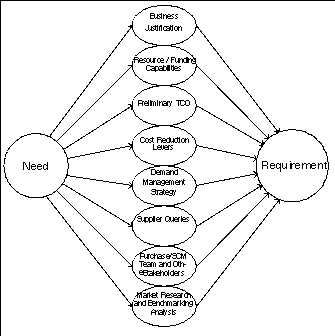|
Supplying Principles and Practices > USPS Supplying Practices Process Step 1: Identify Needs > Define Requirements
Define Requirements
Requirements form the basis for the entire supply chain process. They
provide the necessary detail to understand what is required and to develop a
solution to meet the need. If there is a buy decision, the requirements
contribute to the specification, statement of objectives (SOO), or statement of
work (SOW), as well as to the evaluation of suppliers.
The complexity of a need will determine the extent to which requirements
must be defined. For example, buying a single stapler does not require a
formal requirement definition, but the purchase of new automation equipment
for a facility will require detailed requirement definition.
Figure 1.7 illustrates the methodologies that transform a need into a
requirement. The requirement begins to be defined by drawing on the outputs
from these methodologies.
Figure 1.7
Requirement Inputs Diagram

There are several types of requirements:
• Quality requirements
• Delivery requirements
• Process requirements
• Pricing requirements
• Volume requirements
• Technical requirements
• Location requirements
• Marketing requirements
• Frequency requirements
• Lead-time requirements

The requirement comprises specifications that are used as its description,
including:
• Performance specification (what the product/service is required to
do)
• Functional specification (what is to be achieved, rather than how
it will be done)
• Brand or trade names
• Samples
• Market grades
• Qualified products
• Commercial standards
• Design specifications
• Engineering drawings
• Material and method of manufacture
• Resources
• Warranty support
Specifications should be clear and nonrestrictive. Lack of clarity can be
misleading and result in poor proposals or a more expensive solution than is
necessary. To enhance competition and invite innovation, specifications
should be nonrestrictive, mirror what is in the market, and, whenever
possible, recommend purchasing commercially.
|
